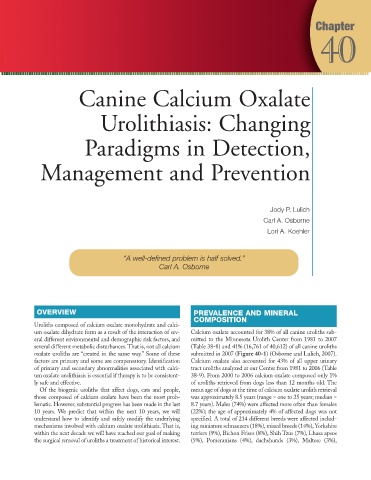Page 824 - Small Animal Clinical Nutrition 5th Edition
P. 824
Chapter
40
VetBooks.ir
Canine Calcium Oxalate
Urolithiasis: Changing
Paradigms in Detection,
Management and Prevention
Jody P. Lulich
Carl A. Osborne
Lori A. Koehler
“A well-defined problem is half solved.”
Carl A. Osborne
OVERVIEW PREVALENCE AND MINERAL
COMPOSITION
Uroliths composed of calcium oxalate monohydrate and calci-
um oxalate dihydrate form as a result of the interaction of sev- Calcium oxalate accounted for 38% of all canine uroliths sub-
eral different environmental and demographic risk factors, and mitted to the Minnesota Urolith Center from 1981 to 2007
several different metabolic disturbances.That is, not all calcium (Table 38-8) and 41% (16,761 of 40,612) of all canine uroliths
oxalate uroliths are “created in the same way.” Some of these submitted in 2007 (Figure 40-1) (Osborne and Lulich, 2007).
factors are primary and some are compensatory. Identification Calcium oxalate also accounted for 43% of all upper urinary
of primary and secondary abnormalities associated with calci- tract uroliths analyzed at our Center from 1981 to 2006 (Table
um oxalate urolithiasis is essential if therapy is to be consistent- 38-9). From 2000 to 2006 calcium oxalate composed only 1%
ly safe and effective. of uroliths retrieved from dogs less than 12 months old. The
Of the biogenic uroliths that affect dogs, cats and people, mean age of dogs at the time of calcium oxalate urolith retrieval
those composed of calcium oxalate have been the most prob- was approximately 8.5 years (range = one to 25 years; median =
lematic. However, substantial progress has been made in the last 8.7 years). Males (74%) were affected more often than females
10 years. We predict that within the next 10 years, we will (22%); the age of approximately 4% of affected dogs was not
understand how to identify and safely modify the underlying specified. A total of 214 different breeds were affected includ-
mechanisms involved with calcium oxalate urolithiasis. That is, ing miniature schnauzers (18%), mixed breeds (14%),Yorkshire
within the next decade we will have reached our goal of making terriers (9%), Bichon Frises (8%), Shih Tzus (7%), Lhasa apsos
the surgical removal of uroliths a treatment of historical interest. (5%), Pomeranians (4%), dachshunds (3%), Maltese (3%),

